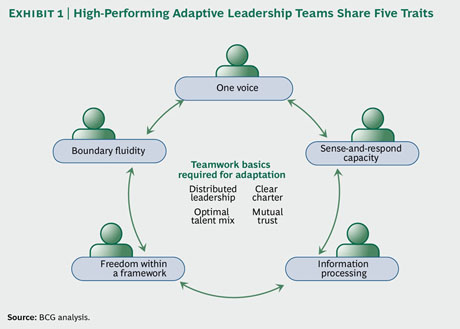“With the flattened hierarchies of today’s distributed corporate environment, the model of the heroic leader who single-handedly produces results through sheer force of will has become obsolete. Leadership at the top is now a team sport. CEOs rely on senior-level teams to accomplish important goals, manage change, and help spread the company’s priorities and values throughout the organization. But in a volatile and uncertain business environment, executives are finding it harder than ever to keep up. Top teams therefore must be more than just high performing. They also need to adapt and thrive, regardless of the turbulence they face.”
-Roselinde Torres and Nneka Rimmer, “The Five Traits of Highly Adaptive Leadership Teams”
In an article published by BCG Perspectives—The Boston Consulting Group, Torres and Rimmer discuss a study titled “The Value of Adaptive Advantage” put out by the BCG Strategy Institute. The study proves that the more adaptive companies are, the more financial gains that company generates. They also consistently outperform their industry peers and sustain superior performance over time.
The article raises interesting questions. Among them:
- What makes an adaptive leadership team?
- What do adaptive team leaders do differently?
- How does adaptation become part of an organization’s DNA?
- How does a leadership team know if it is adaptive enough?
It’s clear that there are basic tenets in place across the board when it comes to highly adaptive teams. From BCG Perspectives’ website, these tenets are:
Distributed Leadership. The team leader believes in the value of sharing leadership at the top and developing leaders at every level.
Optimal Talent Mix. The team is not only composed of the top talent representing key positions and disciplines but also has the chemistry that comes from the right combination of backgrounds, styles, and perspectives.
Clear Charter. The team has defined goals, roles, ground rules, and accountabilities.
Mutual Trust. Team members are able to express divergent views and let down their guard to acknowledge when they need help.
“All the teams studied exhibited these key characteristics of high performance; displayed them at higher levels than other teams; and demonstrated a high correlation between principles of teamwork and their own assessments of team and company performance.”
These basic tenets are clearly instrumental toward forming and nurturing a highly adaptive team. However, the study also determined that in addition to these characteristics, there were five additional traits that high-performing, adaptive leadership teams exhibited. These traits made up a special ‘X-Factor’, so to speak, that set certain teams far apart from the rest. The traits are outlined in the below graphic:
Over the next weeks, we will examine each of these traits on the blog and entertain an in-depth discussion as to what it means for a team to embody each trait, and what leaders can do to ensure their teams are integrating each trait into their day-to-day tasks as well as their big-picture goals.
If you want your company to thrive in the midst of change or even the most volatile of business environments and turbulence, this is an integral part of organisational development from which you’ll benefit immensely. Stay tuned!

